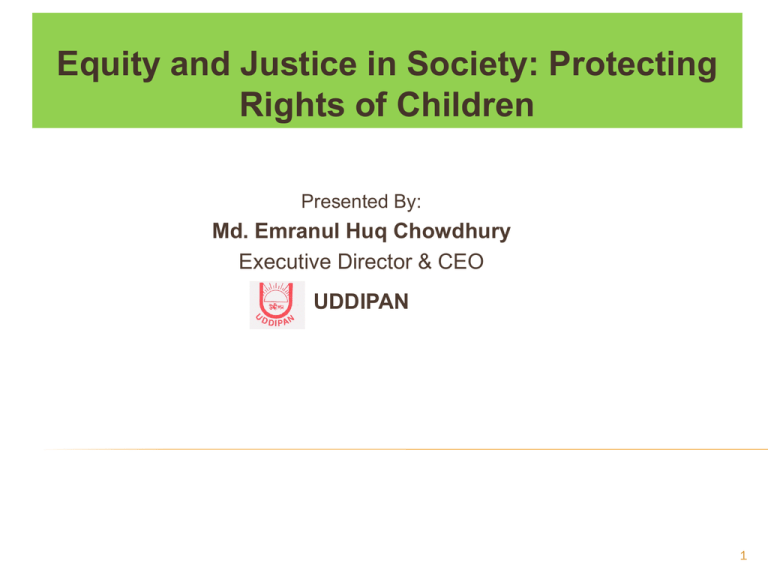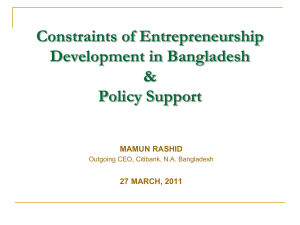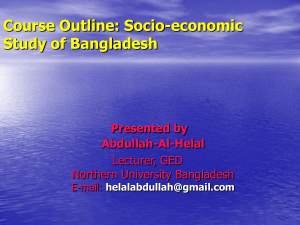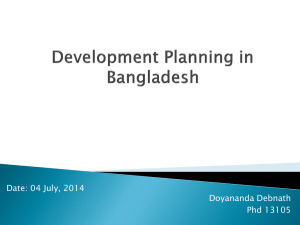
Equity and Justice in Society: Protecting
Rights of Children
Presented By:
Md. Emranul Huq Chowdhury
Executive Director & CEO
UDDIPAN
1
Definition of Child;
UNCRC defines a ‘Child' as a person below the age of 18, unless the laws
of a particular country set the legal age for adulthood younger. The
Committee on the Rights of the Child, the monitoring body for the
Convention, has encouraged States to review the age of majority if it is set
below 18 and to increase the level of protection for all children under 18.
Bangladesh was one of the first 22 countries who ratified UNCRC
immediately after it was adopted in UN general council in 1990
The Children Act 2013 of Bangladesh clearly defined Children as below:
(Art.4.) What ever differences are there in any other laws, to full fill the
objective of this law, any person not exceeding 18 years of age will be
considered as a child.
The Human Trafficking Deterrence & Suppression Act 2012 also defines
child as any person not exceeding the age of 18 years .
2
Child Rights
Children’s Rights are the Human Rights of Children with particular
attention to the rights of special protection and care afforded to minors
including their right to association with both parents, human identity as
well as the basic needs for food, universal state-paid education, health
care and criminal laws appropriate for the age and development off the
child, equal protection of the child’s civil rights, and freedom from
discrimination on the basis of the child’s race, gender, sexual orientation
gender identity, national origin, religion, disability, color, ethnicity, or
other characteristics.
3
Child protection
Child protection is the process which refers to a safe and secured
environment for children from either suffering, or likely to suffer,
significant harm as a result of violations, abuse or neglect. It involves
measures and structures designed to prevent and respond to violation
of right of children.
4
Equity
Equity is about fairness;
Equity derives from a concept of social justice. It represents a belief that there
are some thing which people should have, that there are basic needs that
should be fulfilled, that burdens and rewards should not be spread too
divergently across the community, and that policy should be directed with
impartiality, fairness and justice towards these ends.
It does not mean equal share by all. Response to from both ideological and
practical point of view who needs what. It should start with basic needs, most
vulnerable will get priority.
It is generally agreed that equity implies a need for fairness (not necessarily
equality) in the distribution of gains and losses, and the entitlement of
everyone to an acceptable quality and standard of living.
Sustainable development requires meeting the basic needs of all and
extending to all the opportunity to fulfill their aspirations for a better life,
meeting essential needs requires not only a new era of economic growth for
nations in which the majority are poor, but an assurance that poor get their fair
share of the resources required to sustain that growth."
5
Social Justice
Social justice is justice in terms of the distribution of wealth, opportunities, and
privileges within a society". Classically, ``justice’’ (especially corrective justice or
distributive justice) referred to ensuring that individuals both fulfilled their
societal roles, and received what was due from society.
"Social justice" is generally used to refer to a set of institutions which will enable
people to lead a fulfilling life and be active contributors to their community. The
goal of social justice is generally the same as human development. The relevant
institutions can include education, health care, social security, labour rights, as
well as a broader system of public services, progressive taxation and regulation
of markets, to ensure fair distribution of wealth, equality of opportunity and no
gross inequality of outcome.
6
Social Justice: Contd.
It is important that rights must be realized for children to develop their full
potential, free from hunger and want, neglect and abuse. Children should not
be considered as the property neither of their parents nor are they helpless
objects of charity. They are human beings and are the subject of their own
rights.
Child as an individual and is a member of a family and community, with rights
and responsibilities appropriate to his or her age and stage of development.
Despite the existence of rights, children suffer from poverty, homelessness,
abuse, neglect, preventable diseases, unequal access to education and justice
systems that do not recognize their special needs. These are problems that
occur in both industrialized and developing countries.
7
Available Legal Instruments On Child Rights
Constitution of Bangladesh:
The constitution of Bangladesh guarantees realizing of all rights of children.
Article-27 (4): nothing in this article shall prevent the state from making special
provision in favor of women and children or for the advancement of any backward
of citizens.
Article-32: protection of right to life and personal liberty- no person shall be
deprived the constitution of Bangladesh mandates the establishment of a society
based on the rule of law, justice, and the respect for human dignity and worth
of all persons. The constitution bans forced and bonded labour (article 34) ,
and imposes a duty on the state to prevent and suppress prostitution and
guarantees a number of fundamental human rights. The constitution provides
an obligation for the state to prevent violation of human rights in any form,
including human traffic king. There are also a number of statutes and
policies which provide for the legal regime against human trafficking.
8
Major International Instruments/Conventions ratified by Bangladesh;
• United Nations Convention on the Rights of the Child (UNCRC) - 1990
• Optional Protocol to the Convention on the Rights of the Child on the involvement
of children in armed conflict 2000 (OP - 1)
• Optional Protocol to the Convention on the Rights of the Child on the Sale of
Children, Child Prostitution and Child Pornography (OP - 2)
• Convention on Consent to Marriage, Minimum Age for Marriage and Registration
of Marriages 1964
• ILO Convention 182 - Worst Forms of Child Labour, 1999 - Ratified on 12 Mar
2001
• ILO Convention 006 - Night Work of Young Persons (Industry) Convention, 1919
Ratified on 22 Jun 1972
• ILO Convention 015 - Minimum Age (Trimmers and Stokers) Convention, 1921
Ratified on 22 Jun 1972
• ILO Convention 059 - Minimum Age (Industry) Convention (Revised), 1937
Ratified on 22 Jun 1972
• ILO Convention090 - Night Work of Young Persons (Industry) Convention (Rev.),
1948 Ratified on 22 Jun 1972
By ratifying the conventions, and instruments governments state their firm intention to put this
commitment into practice. State parties are obligated to amend and create laws and policies
to fully implement the convention; they must consider all actions taken in light of the best
interests of the child.
9
Child Rights Policies, Laws and NPA in Bangladesh
The Children Act 1974 was the significant modification of the Probation of
Offenders Act 1964. In the Probation of Offenders Act there were lots of
inconsistencies and inadequate explanation about children. Later with more
modifications, articulations and explanation Children Act 1974 was enacted. It
was a milestone for the rights of the children in Bangladesh. In the Children Act
1974 there were 78 articles under 10 sections. It was a comprehensive law
during that time as far as child rights is concerned. This act was a very
important legal instrument for the wellbeing of the children at that time.
Imprisonment of children, taking care or safe custody, investigation, justice,
judgment and corrections etc were well articulated in the Children Act 1974.
Based on that law, national Juvenile Development Centers were established at
Tongi - Gazipur and at Jessore. Another particularly for the girls was established
at Konabari- Gazipur.
10
Policies, Laws and NPA : Contd.
-The Bangladesh Labor Act, 2006
- National Child Labor Elimination Policy 2010:
- The Prevention of Domestic Violence Act, 2010
- National Education Policy 2010
- National Child Policy 2011
-The Human Trafficking Deterrence and Suppression Act, 2012
- The Pornography Control Act, 2012
- The Children Act, 2013
- NPA in 2013 implement with National Child Labor Elimination Policy
- Fixation of Hazardous job list (38 category of works)
11
Child Rights Situation and Child Protection Status in Bangladesh;
Major issues/areas
Child Labour;
Child labour is a common phenomenon in Bangladesh, with 4.7 million or 12.6% of
children aged below 14 in the work force. Another 6.8% between age 7 and 14 who while
going to school also work. Among the 3.2 million of child labourers of age group of (5-17),
1.3 million involved hazardous labour in the informal sector.
Labour Act 2006 prohibits employment of children less than 14 years of age, as well as
prohibiting hazardous forms of child labour for persons under age 18.
The Ministry of Labour and Employment has recently adopted a National Child Labour
Elimination Policy 2010, which provides a framework to eradicate all forms of child labour
by 2015.
The issue of child labour has been incorporated in all major national development
plans, including the Sixth Five Year Plan (2011-2015), the National Plan of Action to
combat human trafficking (2012-2014), the National Labour Policy, the National Education
Policy (2010), the National Plan of Action for Education for All (2003-2015), the National
Skills Development Policy (2011), and the National Child Policy (2011).
12
Child Rights Situation and Child Protection Status in Bangladesh: Contd.
Child Trafficking;
Bangladesh is a source country for human trafficking a quite big no. whom
are children.
UNICEF reports 200-300 children are bring trafficked to countries every
month.
Women and children from Bangladesh are transported to India and Pakistan,
where they are subjected to commercial sexual exploitation or forced labour.
More than 600 trafficking victims were either self-identified or identified by
civil society groups in 2012.
In February 2012, the government enacted a comprehensive anti-trafficking
law which addressed legislative gaps such as the absence of a prohibition on
the trafficking of men. The government also approved a new anti-trafficking
action plan which incorporated necessary steps to implement the new law.
13
Child Rights Situation and Child Protection Status in Bangladesh:
Contd.
Child Domestic Worker;
There are approximately 400,000 child domestic workers (three-quarters are girls) in
Bangladesh face particular vulnerabilities because they work behind closed doors.
According to a study conducted by Bangladesh Shishu Adhikar Forum (BSAF) in 2010
Almost all child domestic workers work seven days a week and 90 per cent sleep at
their employer’s home, meaning that they are completely dependent on their
employers and often have restrictions on their mobility and freedom.
The year 2013 observed cases of severe abuse and exploitations against child
domestic workers.
According to the findings of the study, the highest number of the child workers
received verbal abuse (95 per cent). Seventy three per cent children received physical
abuse and a significant number of children (17 per cent) stated that they were exposed
to sexual abuse. 52 per cent child domestic workers stated that they are being abused
on a regular basis. Nearly 74 per cent child domestic workers have to work more than
sixteen hours a day and the highest numbers of children work 17-18 hours.
14
Child Rights Situation and Child Protection Status in Bangladesh:
Contd.
Child Sexual Abuse & Exploitation;
In Bangladesh about 20,000 children work as commercial sex workers on the
streets.
Sexual abuse of children and adolescent girls is a growing problem, but this
remains largely hidden due to the stigma attached to the victims of such
offences.
Newspaper reported 150 children raped in 2013 and 19 children committed
suicide after raped.
More than 90% of the abusers were family members and close relatives.
Most of the rape cases go unpunished for various reasons, including lack of
strong evidence, witness, poor forensic examination, corruption by police,
influence of local power on behalf of perpetrator, legal complexities etc.
Street Children;
The number of street children in Bangladesh is estimated to be around
6,79,728
A large percentage are young girls, and they are especially vulnerable to
abuse and exploitation. More 20% of girl street children are forced into
prostitution.
15
Child Rights Situation and Child Protection Status in Bangladesh:
Contd.
Child Marriage;
These is no Act available although a draft law has been cleared by the cabinet
recently place it before the punishment.
Corporal Punishment :
Directives are given by the High Court forbidding corporal punishment on
children at educational institutional & legal actions are ordered on such
offenders.
Children & Political violations ;
The members of political parties and other vested interest groups in
Bangladesh have been using a large number of children (mostly street children)
for different violent activities that include throwing bombs / bricks at police and
cars and on the processions of opposition parties.
In 2013 total 12 children killed/died during political demonstration and it was
noticed that children were used as human shield keeping them in front of the
procession or different violent activities to avert police action
16
Child Rights Situation and Child Protection Status in Bangladesh:
Contd.
Information collected between the period July 13-June 14 revealed that, a total of 1,493
children were victims of different types of abuse and also many were killed in different ways.
Child rights (CR) violation scenario during the period has been demonstrated below. (based
only on the reported case published in 6 national dailies):
Types of violation
Rape
Attempt to rape
Murder after rape
Murder
Attempt to murder
Committing suicide
Attempt to suicide
Kidnapped
Kidnapped and rescued
Murder after kidnapped
Trafficked and rescued
Tortured
Victim of acid throwing
Death by Road accident
Injured by Road accident
Death by drowning
Missing
Death after missing
Death for political vandalism
Injury for use in the political programs
Tortured by teacher
Death for negligence of treatment
Total-
Number
107
18
16
259
12
97
8
47
58
37
52
15
6
211
131
156
29
3
9
29
183
10
1493
17
What we find/see about protection status of children in
Bangladesh
•Children constitute 45% of the total population can we protect our children
from violation and abuse?
•Definitely child protection status in not satisfactory at all;
•There are huge and rampant violation of child rights in Bangladesh.
•Children are not protected despite standard mechanisms in terms of laws,
policies are in place.
The task, however, must engage not just governments but all members of
society. The standards and principles articulated in the convention can only
become a reality when they are respected by everyone—within the family, in
schools and other institutions that provide services for children, in communities
and at all levels of administration.
18
Some major causes of child rights violations in Bangladesh may be
identified as follows;
- Lack of appropriate implementation of laws, policies etc.
- Lack of mechanism to get access to law and other legal instruments
by the children particularly children of poorer families.
- Lack of appropriate awareness of people on child rights.
- Lack of accountability of the duty bearers and care givers.
- Absence of proper democratic practices at the societal level,
institutional and political level (children ombudsman, children division).
- Lack of access to public offices and services.
- Inadequate budgetary allocation for children.
- Poor reporting on children issues.
19
UDDIPAN Experiences
Increase of income and employment of the poorer families together
with massive child rights awareness and practice in the society can
definitely contribute to improve child protection in the country .
Our observation indicates Micro Finance borrowers’ families who
have also received child rights awareness , mobilized to practice child
rights and social monitoring systems works well, child rights situation
in those areas/families are far better than that of others.
20
Way Forward
-Proper implementation of laws, policies must be ensured.
-Protection of child rights should be supervised and monitored extensively by the
government
-Formation committees at different labels as per provisions of Child Rights Act.
2013.
- Ratification of OP3 (Complain Mechanism)
- Establishment of separate directorate or division for children under MOWCA
-Separate Budget tracking system should be in place.
-Child friendly process and justice required and to be in place;
-Establishment of separate court for children;
- Require separate homes for children who are in trial;
- Strengthen UP to protect Child Right through activity standing committee.
-Strong civil society movement is required to ensure child protection;
- Banning on use of children in political activities
- Availability of inclusive services for children with disabilities in every form
of service delivery
- Ensuring children’s rights to quality education
- Inclusion of a special lesson on child rights and protection in academic syllabus
and national board curriculum
21
Way Forward; Contd….
- Govt. Should take initiatives to educate people about provisions of CR in laws,
policies etc.
- Mobilization process for children through child club/children platforms need to
be strengthened in the community;
- Establishment of child ombudsmen
- Child rights education for the parents who are involved in economic
development programs can pave the way to a more protected child rights in
their own localities;
- Community institutions including religious institutions should come under the
umbrella of child rights education and that will lead to a more secured situation
for the children.
- Suggestion/complain box, maintained by children in premises of every
schools/academic institutions
- Review of hazardous job list for children
- Inclusion of child domestic labour in hazardous job list
- Special facility for the child health care, free medicine, and treatment for
children
- Impart training on CRC to the members of law enforcement agency
- Impart training on CRC to the school teachers and school committee members
22
Thanks
for
Your Time
23







